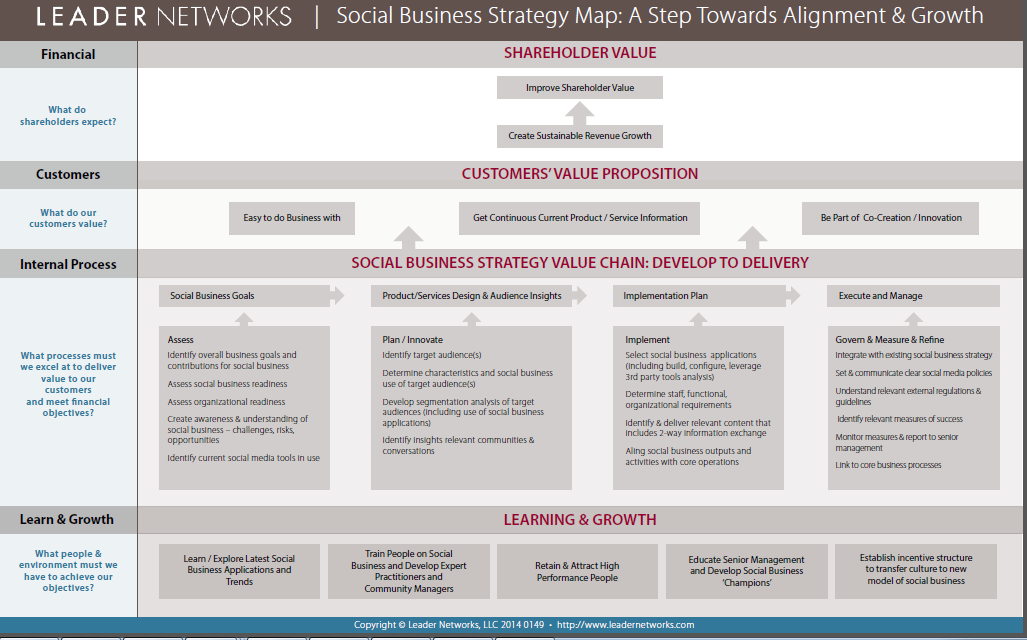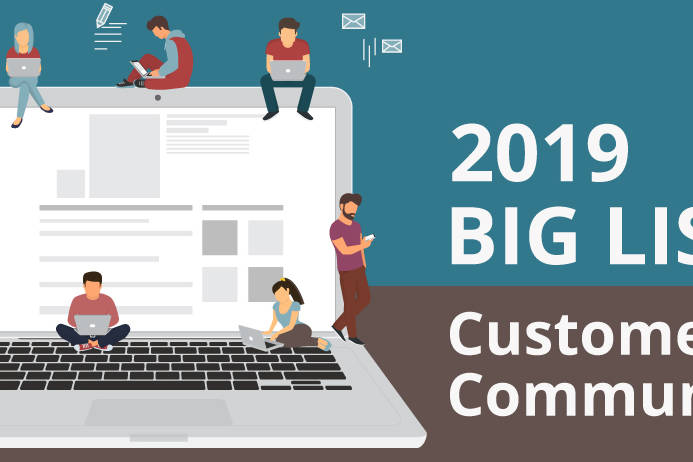A month ago (Jan 2011), I had the pleasure of doing an interview on the Social Business Strategy Map with Neil Davey, Editor of MyCustomer.com in the UK, which is one of Sift Media’s business publications. Neil and I spoke at length about how companies can use the Social Business Strategy Map to create their own strategy and stepped through the process. Because the content is likely to be useful to the members of my community too, Neil gave me the OK to re-post the interview here as well…
Vanessa DiMauro guides us through a strategy map for social business initiatives to help organisations frame this emerging field in a larger business context.
Many businesses are now sold on the value of social media, if not most. But how many of these are developing strategic intentions for social business and social media?
In a call to action, Vanessa DiMauro, CEO of Leader Networks, recently wrote: “The time has come to expand our understanding and use of social media from marketing tactics alone to a higher order strategic initiative. What other efforts in your organisation have the potential to impact customers, product or service innovation, reduce costs and increase shareholder value? Isn’t it about time to start thinking strategically about social?”
In response, late last year Leader Networks developed a generalised strategy map for social media / social business initiatives, based on experiences of developing the strategic frameworks for more than 40 companies. Developed to be adapted to a company’s goals and objectives, the map is just one approach that can be used to help frame this emerging field in a larger business context.
Here, DiMauro guides us through the map. Click the image below to enlarge.
Shareholder value and customers’ value proposition
“It starts with shareholder value and customer values – a place where very few social media marketers are starting. They are looking at brand or shout marketing, instead of what the business needs and what the customers want. But where that overlap exists is where the sweet spot of social media lies. In the map I provide an example based on the aggregate best practices of a lot of my clients (such as ‘easy to do business with’), but this can be adapted so that organisations can shape their own. The examples in the map aren’t always the customer value proposition for an organisation.
For whatever reason – largely because we are in an experimental mode with social media – the perception is that it is primarily a broadcast or marketing opportunity, so organisations don’t really understand or pay attention to the organisations change and impact that social media will bring to their company. Therefore, they often don’t put the same rigour or planning and process attention that they would if it were an innovation project or something of a more serious tenor.
But once the shareholder value and the customer value propositions are established then the heavy lifting begins.”
Internal process – Assess
“Once the values and goals have been identified, the onus is on creating a rigorous internal process, assessing where the organisation’s strengths and weaknesses lie. The importance is really to assess where you stand from your core competences.
An organisation, for example, that is not strong in customer care probably shouldn’t forge really rapidly into social customer care initiatives because it will just put a spotlight on where their weaknesses lie. So you need to really understand your social media capabilities – are you ready as an organisation; do you have training and policy and tools; do people know what to do; do you have core objectives around using the social media activities and tactics? Whether you have a policy in place is very important – you don’t want to open this can of worms in terms of visible exchange and interactivity if you don’t know what your risks and challenges are and how you are going to manage them. And also whether your staff are trained is very important as well. Ask yourself ‘are we ready for this and what do we need to get ready’.”
Internal process – plan and innovate
“Not every organisation wants to go through an enormous transformation and become a social business. You may just want to use it to support and augment certain areas. Then the goal is really to plan and innovate. Identifying target audiences is the most important thing here in my opinion, because very often we think of social media as a large broadcast mechanism but in fact if you interface with your existing CRM data and understand who your most important customers are, you have an opportunity to really target and focus in on supporting and engaging these people more intensively.
Who do you want to reach and in what ways becomes a critical success factor. And then from there you can identify how you are going to reach them, what you hope to get from that interaction – is it testimonials, is it better understanding of their issues and problems, is it supporting a product or service – and, importantly, where do you want to be. It is very important to identify what the relevant communities and conversations are. I recently had problems with AirTran so I turned to social media but when I did a search I found about nine different Twitter accounts, all of which had thousands of followers but no interaction. They didn’t give any thought to what they were going to do after they established that presence, so it wound up being a brand detractor, not a brand supporter.
So where your core constituency can be found and how you engage with them is very important, rather than applying a scattergun approach. Especially in B2B, the customers aren’t necessarily going to be found on the broadbase channels but there might be niche communities or arenas where you can find and interact with the most important customers you have.”
Internal process – implement
“Once you have established who you want to serve and in what ways, then the implementation plan becomes critical and you can start to create robust planning processes for how you are going to reach them, what you hope to get from them and what is required of it.
When I work with a lot of social media managers within enterprises, often social media or social business efforts lie on top of their jobs without any KPIs or additional time or resources. There is often an imbalance between what the anticipated outcomes are and the amount of understanding of effort and attention that needs to be put into it. So if you want the returns that you are seeking you need to be able to understand how you are going to be able to support them with a refined plan. How are you going to do it? Over what period of time? In what ways? What is it going to cost? A real robust plan. And then that implementation plan takes the shape of a traditional project plan, which is often missing in many organisations.”
Internal process – govern, measure and refine
“It is very important to integrate any of the goals and plans with the larger strategicals and plans. They can’t be standalones, they need to dovetail and have ability to be monitored and measured and reported to senior managers.
Very often there is a big schism between the KPIs and the tracking metrics that the social media practitioners rely on and what executive management want to hear. That communication difficulty is often why executives don’t understand the value of social business, because they are not getting information presented in a way that is aligned with their value system. They don’t care how many Twitter followers marketing has gotten, they care about the returns. The ability to connect those raw data and the information that you gather through the social channel back into the core – i.e. you have got this particular footprint, now what did you do with that data and how did it impact change or support the shareholder value – becomes really important.”
Learn and growth – what people and environment must we have to achieve our objectives?
For instance:
- Learn/explore the latest social media tools and trends
- Train people on social media and develop expert practitioners and community managers
- Retain and attract high performance people
- Educate senior management and develop social media ‘champions’
- Establish an incentive structure to transfer culture to the new model of social business
“At the end of the day it is about human processes. The ability to translate the raw data and the information that you gather into actionable results that impact the bottom line require new sets of skills and new rules and if your people aren’t well poised and educated to deliver then a breakdown tends to occur. We find that in many organisations there is an onus put on the staff to use the tools yet the organisation don’t lead by example. This is especially true with internal wikis and knowledge shares, not just external footprints. Knowledge shares get created in organisations yet executives often don’t have the skills or experience to use these.
We’ve had great success with some organisations creating reverse mentoring programmes, because often executives don’t know how to do these things so we partner them with millennials with the organisation so that they become comfortable with the tools and they can start to understand it in context and see the value and understand what is ongoing within the organisation. It is a knowledge transfer and transferring the culture, because social business creates a different dynamic for many organisations. There is an onus put on the organisations when they fully engage to become more responsive, to use the data appropriately, to make judicious decisions about what to act on. When organisations first start experimenting with social business, often everybody leaps on every comment or exchange, with the ability to either parse it or make decisions about what constitutes a trend and is important to act on. So the ability to filter is just as important to respond. But ultimately, changes to culture are fundamental.”
Warning: Attempt to read property "base" on array in /home3/trusten9/public_html/leadernetworks/wp-content/plugins/wp-user-profile-avatar/shortcodes/wp-user-profile-avatar-shortcodes.php on line 665
Warning: Attempt to read property "base" on array in /home3/trusten9/public_html/leadernetworks/wp-content/plugins/wp-user-profile-avatar/shortcodes/wp-user-profile-avatar-shortcodes.php on line 665
Warning: Attempt to read property "base" on array in /home3/trusten9/public_html/leadernetworks/wp-content/plugins/wp-user-profile-avatar/shortcodes/wp-user-profile-avatar-shortcodes.php on line 665
Warning: Attempt to read property "base" on array in /home3/trusten9/public_html/leadernetworks/wp-content/plugins/wp-user-profile-avatar/shortcodes/wp-user-profile-avatar-shortcodes.php on line 665
Related Posts
February 8, 2017
The Business Impact of Online Communities: New Study and Framework
Communities generate revenue, save money and advance competitive advantage.…
December 14, 2016
7 Digital Marketing Predictions for 2017
Predictions for digital transformation in 2017
3 Comments
Add comment Cancel reply
This site uses Akismet to reduce spam. Learn how your comment data is processed.




Hi Vanessa,
This is a really informative and engaging article. I am an internet marketer in my own time, but my job is digital communications at Zeta Agency and the points you raise are important when working with clients and assessing what they want to achieve from social media!
Aimee
Thank you so much Aimee for reading the blog and taking the time to add a comment! Really appreciate it.
best
Vanessa
An excellent post with lots of valuable information.